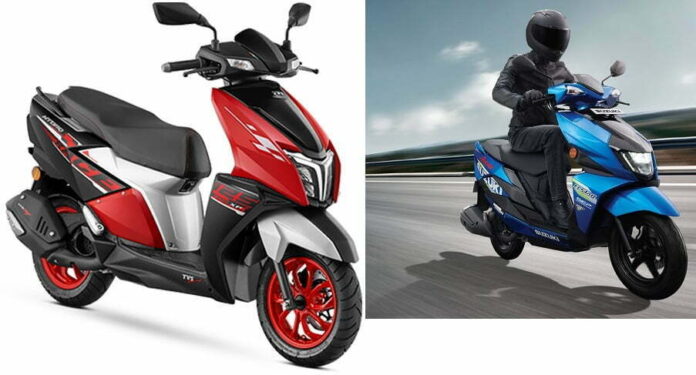The new Avenis scooter launched by the Suzuki Motorcycle India is creating ripples in the market. It has been targeted at the youngsters but in order to win over them, it has to contend with the TVS Ntorq 125. Avenis is banking on its stylish design, peppy motor, and a long list of features although Ntorq 125 has also got many aces up its sleeves. Here’s the detailed comparison that will help you to decide which one of these two you should opt to buy for:
Style and Design
Undoubtedly Avenis is the sportiest scooter in the portfolio of Suzuki. It comes with the integrated LED headlamp and the indicators placed on the handlebar cowl looks really stylish. A 12-inch front and 10-inch rear alloy wheels add to its appeal and a stepped single-seat aids the utility factor. Other important design highlights include a dual-tone paint scheme, sporty muffler, LED taillight, and split grab rails for the pillion. Customers can also opt for the special race edition of the scooter which has a paint scheme inspired by the MotoGP.
TVS Ntorq 125 has also got a very sporty turnout although it is less edgy in comparison to the Suzuki Avenis. It also features stepped single-seat, sporty alloys please, LED headlamp and tail lamp, and split grab rails. Both front and rear wheels measure 12-inch and Ntorq provide customers with an option to choose from multiple variants and paint schemes including the Super Squad Edition inspired by Marvel.
Features and Equipment
The prominent features available on the Suzuki Avenis include an external fuel filler cap, USB charging port, Bluetooth enabled smartphone connectivity, and a fully digital LCD instrument cluster display. The connected features available on the scooter include missed call alerts, phone notifications, and turn-by-turn navigation.
Suspension duties on the Suzuki are handled by the telescopic forks at the front and monoshock suspension at the rear. The standard braking option includes a combination of disc and drum brake at front and rear respectively.
Ntorq 125 is also generously equipped with features such as an LCD digital instrument cluster, Bluetooth enabled smartphone connectivity, optional USB charging port, kill switch, external fuel filler cap, and telescopic front fork and rear monoshock suspension system. The connected features available here include the caller ID, ride statistics, and turn-by-turn navigation. The base variant of Ntorq gets drum brakes on both front and rear while the higher variants feature disc front brakes as a standard part of the equipment. The Ntorq also offers the features of an LED headlamp and hazard lights on the race XP edition, race edition, and SuperSquad editions of the Scooter.
Engine and Performance
Powering Ntorq 125 is a 124.8cc air-cooled single-cylinder engine that is capable of producing 10.2 PS and 10.8 Nm on the top-spec Race XP variant. All other variant comes with an output of 9.38 PS and 10.5 Nm and CVT is the standard part of the equipment on all variants.
Avenis 125, on the other hand, displaces 124.3cc and delivers 8.7 PS and 10 Nm to wheels through CVT. These numbers pale in comparison to Ntorq which means TVS has a considerable advantage over Suzuki on the performance aspect.
Price and Value for Money
Suzuki Avenis 125 costs Rs 86,700 and Rs 87,000 for Ride Connect and Race Editions respectively. The price is no doubt on the higher side though with all the equipment on offer, it won’t act as a deal-breaker. That said, Suzuki should have equipped the scooter with more powerful performance.
Pricing of TVS Ntorq 125 starts at Rs 73,270 for the standard drum brake variant. The pricing of the disc variant starts from Rs 77,725 while Race Edition, Super Squad Edition, and Race XP Edition can be had at Rs 81,225, Rs. 83,825, and Rs. 85,025 respectively, making the scooter more value for money than the Suzuki. Also, TVS offers better performance which further consolidates its advantage over the Suzuki Avenis 125 in this comparison review.




